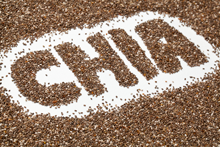When you hear “chia” your first thought may be of the green fur or hair of Chia Pets, collectible clay figurines. But did you know that chia seeds can also be a healthful addition to your diet?
Chia seeds come from the desert plant Salvia hispanica, a member of the mint family. Salvia hispanicaseed is often sold under its common name “chia” as well as several trademarked names. Its origin is believed to be in Central America where the seed was a staple in the ancient Aztec diet. The seeds of a related plant, Salvia columbariae (golden chia), were used primarily by Native Americans in the southwestern United States.
Chia seeds have recently gained attention as an excellent source of omega-3 fatty acid. They are also an excellent source of fiber at 10 grams per ounce (about 2 tablespoons), and contain protein and minerals including as iron, calcium, magnesium and zinc.
Emerging research suggests that including chia seeds as part of a healthy diet may help improve cardiovascular risk factors such as lowering cholesterol, triglycerides and blood pressure. However, there are not many published studies on the health benefits of consuming chia seeds and much of the available information is based on animal studies or human studies with a small number of research participants.
How to Eat Chia Seeds
Chia seeds can be eaten raw or prepared in a number of dishes. Sprinkle ground or whole chia seeds on cereal, rice, yogurt or vegetables. In Mexico, a dish called chia fresco is made by soaking chia seeds in fruit juice or water. Chia seeds are very absorbent and develop a gelatinous texture when soaked in water making it easy to mix them into cooked cereal or other dishes.
The seeds are not the only important part of the chia plant; the sprouts are also edible. Try adding them to salads, sandwiches and other dishes.

